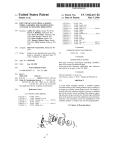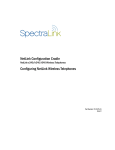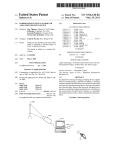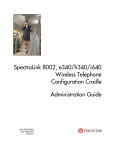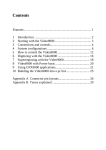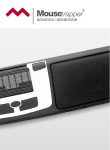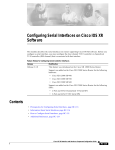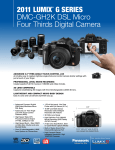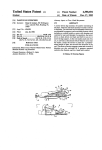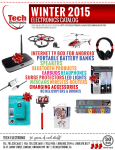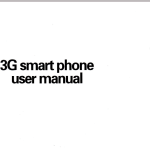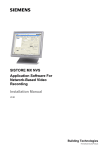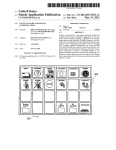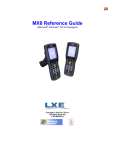Download Modular scroll wheel with integral detent
Transcript
US006987505B1 (12) United States Patent (10) Patent N0.: (45) Date of Patent: Koo (54) MODULAR SCROLL WHEEL WITH INTEGRAL DETENT-ENGAGING SPRING TAB US 6,987,505 B1 Jan. 17, 2006 “Photo B”: (second) photograph of scroll Wheel from LOG ITECH cordless optical mouse, P/N 851497—0000; date of ?rst availability and/or disclosure prior to (or believed to be prior to) application ?ling date. (75) Inventor: James Y. Koo, Renton, WA (US) “Photo C”: photograph of scroll Wheel from mouse manu (73) Assignee: Microsoft Corporation, Redmond, WA factured by A4tech Co., Ltd., Taipei, TaiWan; date of ?rst avaliability and/or disclosure prior to (or believed to be prior (Us) (*) Notice: to) application ?ling date. Subject to any disclaimer, the term of this patent is extended or adjusted under 35 U.S.C. 154(b) by 52 days. “Photo D”: (second) photograph of scroll Wheel from mouse manufactured by A4tech Co., Ltd., Taipei, TaiWan; date of ?rst availability and/or disclosureprior to (or believed to be prior to) application ?ling date. “Photo E”: photograph of scroll Wheel from mouse manu (21) Appl. No.: 10/158,996 (22) Filed: factured by KYE Systems, Taipei, TaiWan; date of ?rst availability and/or disclosure prior to (or believed to be prior Jun. 3, 2002 to) application ?ling date. “Photo F”: photograph of scroll Wheel from RAZER (51) Int. Cl. 609G 5/08 (2006.01) (52) US. Cl. ..................... .. 345/163; 345/156; 345/157; (58) Field of Classi?cation Search ....... .. 345/163—167, 345/158; 345/164; 345/165; 345/166; 345/167 345/156—158 See application ?le for complete search history. (56) References Cited “Boomslang” mouse, available from Kama LLC, TaiWan; date of ?rst availability and/or disclosure prior to (or believed to be prior to) application ?ling date. * cited by examiner Primary Examiner—Vij ay Shankar Assistant Examiner—Leonid Shapiro (74) Attorney, Agent, or Firm—Banner & Witcoff, Ltd. (57) ABSTRACT U.S. PATENT DOCUMENTS A single-piece component rotatably supports a scroll Wheel 5,808,568 A * 9/1998 Wu ........................... .. 341/20 5,912,661 A * 6/1999 Siddiqui 6,188,393 B1 * 2/2001 Shu 6,340,966 B1 * ... ... ... ... . . . . .. 345/166 . . . .. 345/184 1/2002 Wang et al. .............. .. 345/163 6,353,429 B1 3/2002 Long 6,522,321 B1 * 6,570,108 B2 * 2/2003 5/2003 2005/0104854 A1 ...... Chen et al. ............... .. 345/163 Lin .......................... .. ZOO/6 B 5/2005 Su et 211. OTHER PUBLICATIONS “Photo A”: photograph of scroll Wheel from LOGITECH cordless optical mouse, P/N 851497—0000; date of ?rst availability and/or disclosure prior to (or believed to be prior to) application ?ling date. and includes an integral folloWer arm extending into a Well Within Which the scroll Wheel rotates. Formed on a circum ferential surface of the scroll Wheel are regularly spaced detents or other structures forming regularly spaced regions of alternating height. Located on an end of the folloWer arm is a folloWer Which moves in and out of the detents as the scroll Wheel rotates, With the arm biasing the folloWer against movement out of the detents. The carriage may also include pivots for relative movement of the carriage and scroll Wheel assembly With respect to a housing, and a tab for actuating a sWitch. 20 Claims, 10 Drawing Sheets U.S. Patent Jan. 17, 2006 Sheet 1 0f 10 FIG. 1 US 6,987,505 B1 U.S. Patent Jan. 17, 2006 Sheet 2 0f 10 FIG. 2 US 6,987,505 B1 U.S. Patent Jan. 17, 2006 Sheet 3 0f 10 74 76 FIG. 3 US 6,987,505 B1 U.S. Patent Jan. 17, 2006 Sheet 4 0f 10 l. (I,, 2U FIG. 4 US 6,987,505 B1 U.S. Patent Jan. 17, 2006 Sheet 5 0f 10 FIG. 5 US 6,987,505 B1 U.S. Patent Jan. 17, 2006 FIG. 6 Sheet 6 6f 10 US 6,987,505 B1 U.S. Patent Jan. 17, 2006 Sheet 7 0f 10 US 6,987,505 B1 24/‘ ——-56 74 74 92 FIG. 7 U.S. Patent Jan. 17, 2006 Sheet 8 0f 10 US 6,987,505 B1 67 2 50. 5 FIG. 8 AU. 2 5 m m D 9» LI an n I D e p It h FIG. 8A U.S. Patent FIG 1 0 Jan. 17, 2006 Sheet 9 0f 10 US 6,987,505 B1 U.S. Patent Jan. 17, 2006 Sheet 10 0f 10 66 FIG. 11 US 6,987,505 B1 US 6,987,505 B1 1 2 MODULAR SCROLL WHEEL WITH INTEGRAL DETENT-ENGAGING SPRING TAB spring biased into contact With the axle detents, a plastic bracket contacts the axle near one of its rotational hubs and biases the axle upWard so as to provide Z-sWitch function ality. A folloWer, located Within the portion of the bracket cradling the axle, is thereby simultaneously biased into FIELD OF THE INVENTION contact With the detents. Further improvements are possible, This invention relates to scroll Wheels on mice, trackballs and other user input devices. BACKGROUND OF THE INVENTION 10 In many computers, user input (e.g., cursor control, screen hoWever. For example, the con?guration described in the ’429 patent requires assembly of at least 4 parts to provide indexed rotation. Because each of these parts (like all mechanical components) Will have dimensional tolerances, a “tolerance stack-up” of the assembly results. This toler ance stack-up can potentially result in a rotational torque that may vary from mouse to mouse unless relatively small such as a mouse or a trackball. A typical computer mouse 1 tolerances are maintained. This can increase manufacturing is shoWn in FIG. 1. Mouse 1 has a case 16 having a bottom 15 expense. scrolling, etc.) is often achieved by Way of a pointing device case 20 and an upper case 18. As a user slides mouse 1 across In another con?guration, regularly-spaced radially a planar (or substantially planar) surface, motion detectors extending indentations are molded into (or otherWise formed and encoders Within case 16 may convert the tWo dimensional movement of the mouse across the surface into horiZontal and vertical motion of a cursor, pointer, or other object on a computer screen. Mouse 1 has tWo buttons 8 and in) a side of a scroll Wheel in a spoke-like arrangement A folloWer piece is biased into contact With the spoke-like indentations on the side of the Wheel. The folloWer piece may be a molded extension of a carriage or other structure 12 Which a user can “click” or “double click” to select supporting a Wheel axle, or it may be a separate member that something on a computer screen. Other mice may have is attached to the carriage. A potential disadvantage of this feWer or additional buttons, or other features. Mouse 1 may con?guration, hoWever, is the variability in torque required be connected to a computer or other device by a cord 5 25 to rotate the Wheel in one direction versus the other. In the through Which mouse 1 may receive poWer and communi case of a separate member attached to the carriage, an cate With a computer (or other device). Alternatively, mouse 1 could be battery poWered and communicate via a Wireless connection. additional part is required, resulting in additional assembly steps, cost and potential tolerance stacking problems. In yet another con?guration, the indentations are not formed in the side of the Wheel in a spoke-like arrangement. Instead, a series of ridges and/or depressions are formed on an inner Mouse 1 also has a scroll Wheel 14. Scroll Wheel 14 is located such that the mouse user can comfortably turn the scroll Wheel With a ?nger. The mouse and/or computer may be con?gured such that turning the Wheel causes the screen image to scroll upWards or doWnWards. The scroll Wheel may be con?gured to perform other functions, such as circumference of the Wheel. A folloWer is biased radially outWard into contact With the ridges and/or depressions. HoWever, knoWn scroll Wheels implementing this con?gu 35 moving a screen object in a Z direction; changing the Zoom or other attributes of a screen image; scrolling horiZontally; integral part of the carriage supporting the Wheel axle. A scroll Wheel having circumferential detents that are acted upon by a biased folloWer integrally formed as part of and innumerable other functions. Ascroll Wheel may also be con?gured to act as an additional button When pressed by the user. 40 To prevent the scroll Wheel from rotating undesirably (e. g., When the user is moving the mouse but not turning the Wheel), to provide a desired tactile sensation for the user, and to provide a means of indexing Wheel rotation into discrete increments, some type of restraint is typically imposed on greater performance consistency among the scroll Wheels in be obtained from further re?nements in scroll Wheel design. 45 SUMMARY OF THE INVENTION The present invention improves upon existing scroll Wheel designs by providing a single component that rotat ably supports the scroll Wheel, and Which has an integral folloWer arm extending into a Well Within Which the scroll necessary to continue rotating the Wheel increases slightly. As the user increases the applied torque (i.e., continues to turn the Wheel), the folloWer rides over a ridge (or other structure separating tWo detents), Whereupon the needed Wheel rotates. Formed on a circumferential surface of the scroll Wheel are regularly spaced detents or other structures forming regularly spaced regions of alternating height. Located on an end of the folloWer arm is a folloWer Which 55 relatively uniform scrolling movements. rests Within the detents. As the scroll Wheel rotates and the folloWer is pushed out of a detent, the folloWer arm biases the folloWer radially into the surface on Which the detents are located. By integrally forming the folloWer and folloWer Existing mice scroll Wheels restrain Wheel rotation through a variety of con?gurations. US. Pat. No. 5,912,661, titled “Z-Encoder Mechanism” and oWned by assignee of arm as part of the same component that houses and rotatably supports the scroll Wheel, the number of components is reduced, reducing tolerance stack-up and providing other advantages. The carriage may further be pivotably attached this invention, describes a con?guration in Which the detents are located on the axle of the scroll Wheel. A metal spring attached to a printed circuit board Within the mouse biases a folloWer into contact With the detents. An improvement upon this con?guration is described in US. Pat. No. 6,353, 429, titled “Detented Optical Encoder” and also oWned by the assignee of this invention. Speci?cally, instead of a metal the carriage Would result in advantageous savings in assem bly steps and expense. Such a design Would also facilitate greater control over the ?t of the components and alloW different nice. For these and other reasons, advantages can scroll Wheel rotation. Acommon restraint consists of a series of regularly-spaced ridges, detents or other structures on a surface of the Wheel or its axis, and a folloWer biased into contact With the detents. As the Wheel rotates, the folloWer is biased to resist movement out of a detent, and the torque torque decreases until the folloWer is biased into the next detent. In this Way, the user can easily gauge (and make) ration utiliZe a separate biasing member that is not an to a mouse or other structure, and a tab formed on the 65 carriage. In this manner, the scroll Wheel can also function as an externally depressible button. In one embodiment, a modular scroll Wheel assembly includes a scroll Wheel siZed for movement by a ?nger of a US 6,987,505 B1 3 4 human user. The scroll Wheel has a circumferential surface FIG. 2, the upper case, as Well as buttons 8 and 12, have been removed for purposes of illustration. Located Within mouse 1 and attached to loWer case 20 is a printed circuit board 44. With regularly spaced regions of alternating height located on that surface. The modular scroll Wheel assembly further includes a single-piece carriage that supports and rotatably Printed circuit board 44 electrically interconnects various holds the scroll Wheel. The carriage has ?rst and second mouse components, and also provides an internal structure to Which other components may be attached. Scroll Wheel 14 has an attached axle 22. Axle 22 rotates Within axle guides sides that de?ne a Wheel Well Within Which the scroll Wheel rotates. An integral folloWer arm is disposed on the ?rst side of the carriage; the folloWer arm has a folloWer in contact With the circumferential surface and is biased to resist de?ection as the scroll Wheel rotates. An embodiment of a computer mouse according to the 10 58 (see FIG. 3) de?ned Within carriage 56. The mouse of FIGS. 1—11 is used only by Way of example. Persons skilled in the art Will appreciate that the invention is likeWise invention includes a housing siZed and con?gured for applicable to other mouse designs. Such persons Will also appreciate that the invention is likeWise applicable to manual movement by a user across a surface so as to permit a corresponding movement of a screen object on a computer capable of having) a scroll Wheel. trackballs, keyboards and other input devices having (or display. The housing has a bottom case and an upper case coupled to the bottom case, and at least tWo depressible 15 buttons movably attached to the upper case. The mouse further includes a scroll Wheel having a circumferential FIG. 3 is an “exploded” front perspective vieW of an embodiment of the improved scroll Wheel assembly accord ing to the present invention. The upper case of the mouse has been removed for clarity, and various circuit components surface With regularly spaced regions of alternating height also omitted for purposes of clarity. Most of the loWer case of the mouse has also been removed, With portion 20‘ representing a small part of the loWer case 20. FIG. 4 is similar to FIG. 3, but in an assembled condition. Scroll Wheel 14 may (but need not) include an outer surface 15 that located around that circumferential surface. A single-piece carriage rotatably supports the scroll Wheel such that a portion of the scroll Wheel extends outside of the housing. The carriage includes ?rst and second sides forming a Wheel Well Within Which the scroll Wheel rotates, and an integral is textured to alloW for easier movement by the user. In the folloWer arm on the ?rst side of the carriage. A folloWer on an end of the arm is in contact With the circumferential 25 depicted embodiment, scroll Wheel 14 includes a hub 49 that is substantially open on at least one face, and has an exposed surface and is biased to resist de?ection as the scroll Wheel inner circumferential surface 50 exposed by the opening in that face. Evenly spaced along inner circumferential surface rotates. Other features and advantages of the invention are set forth beloW in the detailed description or Will be apparent to 50 are a series of peaks and troughs forming detents 52. The series of peaks and troughs may include a sinusoidally shaped series of peaks and troughs. Axle 22 is attached to persons skilled in the art in light of that description. BRIEF DESCRIPTION OF THE DRAWINGS Wheel 14, Which attachment may be strengthened by spokes FIG. 1 is perspective outer vieW of a computer mouse 54. Wheel 14, axle 22 and spokes 54 may be molded so as having a scroll Wheel. to form a single integral component. FIG. 2 is a front perspective vieW, With the upper case After assembly, a portion of scroll Wheel 14 rests Within 35 removed, of the mouse of FIG. 1. carriage 56. Carriage 56 is a single, integral piece Which can FIG. 3 is an exploded front perspective vieW of a scroll be molded. Carriage 56 includes axle guides 58 on both sides of carriage 56. Each axle guide 58 may be formed Wheel, carriage and other internal components of the mouse of FIG. 1. FIG. 4 is an assembled front perspective vieW of a scroll Wheel, carriage and other internal components of the mouse of FIG. 1. FIG. 5 is another assembled front perspective vieW of a scroll Wheel, carriage and other internal components of the mouse of FIG. 1, but from a different angle than that of FIG. 4. FIG. 6 is another exploded front perspective vieW of a 40 an angled inlet betWeen uprights 60, other axle guide con ?gurations are possible. For example, one axle guide 58 could be an enclosed hole (e.g., Without a gap betWeen the 45 scroll Wheel, carriage and other internal components of the mouse of FIG. 1, but from a different angle than that of FIG. 3. FIG. 7 is a top vieW of a scroll Wheel, carriage and other internal components of the mouse of FIG. 1. FIG. 8 is a cut-aWay vieW taken along lines 8—8 of FIG. 7. FIG. 8A is an enlarged vieW of a region of FIG. 8 that has been rotated 90° counterclockwise. FIG. 9 is a perspective vieW of a scroll Wheel carriage betWeen a pair of uprights 60 extending from (and integral to) carriage 56. Although both axle guides 58 are shoWn in the draWings as having a “snap-in” con?guration formed by uprights 60) into Which one end of axle 22 is inserted, With the other end of axle 22 being snapped into the other axle guide. Each axle guide 58 supports axle 22 for rotation, and is slightly larger in diameter than the portion of axle 22 that ?ts therein so as to alloW rotation of axle 22 and Wheel 14. Carriage 56 further has an integral folloWer arm 67 and folloWer 66. FolloWer arm 67 projects inWardly toWards scroll Wheel 14 and is used to provide indexed Wheel motion. After assembly, and as shoWn in FIG. 4, folloWer 66 (located on the inWardly projecting end of folloWer arm 67) 55 is in contact With the inner circumferential surface 50. As Wheel 14 is rotated Within the Wheel Well 57 formed by carriage 56, folloWer 66 is alternatively forced out of, and alloWed to descend into, detents 52. As folloWer 66 is forced out of a detent 52, it is pushed radially inWard against a radially outWard bias of the spring force of folloWer arm 67. In this manner, indexed rotation of scroll Wheel 14 is according to the invention. FIG. 10 is an enlarged perspective vieW of a region of FIG. 9. FIG. 11 is an enlarged top vieW of the folloWer arm and obtained, and scroll Wheel 14 is prevented from rotating a portion of the carriage. An improved scroll Wheel assembly according to the except When such rotation is desired. FIG. 9 is a perspective vieW of carriage 56 Without scroll Wheel 14. FIG. 10 is an enlarged vieW of the region 10 of FIG. 9, and shoWs exemplary dimensions for folloWer 66 present invention is shoWn in FIGS. 1—11. With reference to and arm 67. Dimensions may vary depending on material, DETAILED DESCRIPTION OF THE INVENTION 65 US 6,987,505 B1 5 6 scroll-wheel size, and other factors. As shown in FIG. 11 one side of carriage 56, shown as item 74‘ in FIG. 7. Circuit board 44 may also house components for tracking mouse (which is a top view of the region shown in perspective in FIG. 10), the face 80 of arm 67 facing toward the detents may be straight when the follower 66 is centered within a trough (i.e., within a detent). As the dotted line shows, arm movement across a surface, such as LED 91 and receptor 92. Alternatively, mechanical encoder wheels and a captive rolling ball could be used, as could other motion tracking devices. FIG. 8 is a cutaway view taken along the line of sight 8—8 of FIG. 7. Various components have been com 67 ?exes backward when force is exerted on follower 66. As shown if FIGS. 2—6, carriage 56 may be mounted for pletely or partially removed so as to more clearly reveal detents 52 and follower 66. As shown in FIG. 8, a scroll pivotal movement within a mouse or other structure. Car riage 56 may include pivots 68. Pivots 68 ?t within pivot guides 70 formed in posts 72, and are retained therein for pivotal movement. In the depicted embodiment, snap-?t pivot guides are shown; as with axle guides 58, however, 10 region 8A of FIG. 8, and has been rotated 90° counterclock wise for clarity. FIG. 8A shows dimensions for the embodi alternative arrangements are possible. Posts 72 are attached to (or formed as a part of) lower case 20‘. Carriage 56 thereby pivots about an axis Apassing through pivots 68 and pivot guides 70. Located at the opposite end of carriage 56 wheel in one embodiment of the invention may have eigh teen (18) evenly-spaced detents 52 distributed on inner circumferential surface 50. FIG. 8A is an enlarged view of ment of FIG. 8, but the dimensions, shapes and positioning 15 of the components may vary as desired. Follower 66 has a is switch tab 74. Switch tab 74 acts upon microswitch 76 when the user exerts downward force on wheel 14; switch shape generally matching the trough shape. Fatigue on tab 74 is thereby pressed against microswitch 76, and is substantially no preload upon the follower. In other words, when the scroll wheel is assembled and follower 66 is substantially centered within a detent 52, no signi?cant force follower 66 and the follower arm 67 may be reduced if there actuates same. Microswitch 76 can be a self-biased switch such as a metallic beam switch, a metallic disc switch, or is exerted on follower 66 or arm 67 by wheel 14. other type self-biasing switch which will support the car riage when not being pressed down by a user. As is known in the art, these types of switches are mechanically biased to As is clear from the above description, the invention provides numerous advantages over other scroll wheel con an “off” state, and are only “on” when an external force is exerted on the switch. Although not shown, carriage 56 could alternatively be biased upward by a separate spring or resilient member. In such an alternative con?guration switch 25 the follower arm. Because there are a minimum number of 76 would not need to be self-biased. FIG. 6 is an exploded front perspective view of the mouse and scroll wheel from an opposite side of the mouse. FIG. 5 is similar to FIG. 6, but in an assembled condition and showing additional components. Encoder wheel 24 is attached to (or formed as a part of) the end of axle 22. After assembly, and as shown in FIGS. 2 and 5, encoder wheel 24 passes between a light emitting diode (LED) 42 and receptor (s) 46. When scroll wheel 14 is rotated, the “spokes” of encoder wheel 24 alternatively allow and block light from ?gurations. Contained within a single part are the guides within which the scroll wheel axles rotate, the follower and 35 parts, tolerances can be more easily and accurately main tained. This in turn enhances consistency in scroll wheel performance from mouse to mouse. Reducing the number of parts also reduces assembly time and expense. The invention further provides a consistent feel for a user rotating the scroll wheel in either direction. In other words, the forward and reverse rotational torque is more closely equal than is the case in other designs. Although an example of carrying out the invention has been described, those skilled in the art will appreciate that there are numerous variations and permutations of the above LED 42 from reaching receptor(s) 46, thereby facilitating described device that fall within the spirit and scope of the detection of scroll wheel rotation. The details of such detection are known in the art, and are not critical to the present invention. The detents 52 could be con?gured such that, when the follower 66 rests within a detent, light from LED 42 reaches receptor(s) 46. Alternatively, detents 52 could be con?gured so that, when the follower 66 rests within a detent, the encoder wheel 24 partially or completely 40 blocks light from LED 42 from reaching receptor(s) 46. 45 LED 42 and receptor(s) 46 can be mounted upon a bracket 26, which could in turn be mounted to circuit board 44. In one embodiment, hub 49 of scroll wheel 14, axle 22 invention as set forth in the appended claims. As but one example, the detents could alternatively be located on an inner circumferential surface that is on a portion of the scroll wheel axle inside of the wheel hub, with the follower facing radially inward. As another example, the detents could be molded (or otherwise formed) on the outermost surface of the scroll wheel, the carriage modi?ed, and the follower oriented to face radially inward. As yet another example, the axle could alternatively be molded as two half axles extend ing from either side of the carriage into the wheel well, with depressions molded into the scroll wheel for those half axles. and spokes 54 may be integrally formed from any desired plastic such as an acetyl resin (for example, DELRIN®, As set forth above, the scroll wheel of the invention can be available from E1. duPont de Nemours and Company of incorporated into other mouse designs, into other pointing Wilmington, Del.). If desired, a rubber-like thermoplastic devices (e.g., trackballs), and other input devices (e.g., elastomer such as SANTOPRENE® (available from keyboards). These and other modi?cations are within the scope of the invention, which is to be limited only by the claims. What is claimed is: Advanced Elastomer Systems of Akron, Ohio) may be overmolded or otherwise used to form an outer surface 15 of 55 wheel 14. Carriage 56 may also be molded from a plastic, for example Acrylonitrile Butadiene Styrene 1. A modular scroll wheel assembly, comprising: The described materials are exemplary, however, and other mate rials and combinations are with thin scope of the invention. a scroll wheel siZed for movement by a ?nger of a human user having a circumferential surface having regularly spaced regions of alternating height located thereon; A small amount of lubricantican be added to the connec tions between axles 22 and axle guides 58 and between follower 66 and detents 52. and a single-piece carriage supporting and rotatably holding the scroll wheel, the single-piece carriage having: FIG. 7 is a top view of one embodiment of the invention installed on a mouse circuit board 44, with certain compo directly opposite the pivots 68, switch tab 74 could be ?rst and second sides de?ning a wheel well within which the scroll wheel rotates; and an integral follower arm on the ?rst side of the carriage, located elsewhere. For example, switch tab 74 could be on the follower arm having a follower on an end of the nents omitted. Although shown in certain ?gures as located 65 US 6,987,505 B1 8 7 at least tWo depressible buttons movably attached to the follower arm extending into the Wheel Well from the ?rst side of the carriage, the follower being in contact upper case; With the circumferential surface and biased to resist a scroll Wheel having a circumferential surface having regularly spaced regions of alternating height located de?ection as the scroll Wheel rotates. 2. The modular scroll Wheel assembly of claim 1, Wherein the scroll Wheel further comprises ?rst and second faces, and thereon; and a single-piece carriage rotatably supporting the scroll Wherein an opening is de?ned in the ?rst face so as to expose Wheel such that a portion of the scroll Wheel extends the circumferential surface. 3. The modular scroll Wheel assembly of claim 2 Wherein outside of the housing, the single-piece carriage hav the carriage is molded. 4. A modular scroll Wheel assembly of claim 3, Wherein: the scroll Wheel further comprises an integral axle, and the carriage further comprises ?rst and second axle guides, respectively formed Within the ?rst and second sides of the carriage, rotatably holding the axle. 5. The modular scroll Wheel assembly of claim 4, Wherein the folloWer faces radially outWard With respect to the axle, and Wherein the circumferential surface faces radially 10 mg: ?rst and second sides forming a Wheel Well Within Which the scroll Wheel rotates, and an integral folloWer arm on the ?rst side of the carriage, the folloWer arm having a folloWer on an end of the 15 arm extending into the Wheel Well from the ?rst side of the carriage, the folloWer being in contact With the circumferential surface and biased to resist de?ec tion as the scroll Wheel rotates. 10. The computer mouse of claim 9, Wherein the scroll Wheel further comprises ?rst and second faces, and Wherein an opening is de?ned in the ?rst face so as to expose the inWard. circumferential surface. 11. The computer mouse of claim 10, Wherein the carriage 6. A modular scroll Wheel assembly, comprising: a scroll Wheel siZed for movement by a ?nger of a human is pivotably coupled to the housing, and further comprising: a sWitch actuating tab extending from the carriage; and user having a circumferential surface having regularly spaced regions of alternating height located thereon; and 25 a single-piece carriage supporting and rotatably holding the scroll Wheel, the carriage having: the folloWer arm having a folloWer on an end of the folloWer arm extending into the Wheel Well from the ?rst side of the carriage, the folloWer being in contact 35 is self-biased. 14. The computer mouse of claim 13, Wherein the fol loWer faces radially outWard With respect to the axle, and Wherein the circumferential surface faces radially inWard. 15. The computer mouse of claim 14, Wherein the Wherein the scroll Wheel further comprises ?rst and second faces, and Wherein an opening is de?ned in the ?rst face so as to expose the circumferential surface. Wherein the carriage is molded Wherein the scroll Wheel further comprises an integral force upon the scroll Wheel pivots the carriage and pushes the tab against the sWitch. 12. The computer mouse of claim 11, Wherein: the scroll Wheel further comprises an integral axle, and the carriage further comprises ?rst and second axle guides, respectively formed Within the ?rst and second sides of the carriage, that rotatably hold the axle. 13. The computer mouse of claim 12, Wherein the sWitch ?rst and second sides de?ning a Wheel Well Within Which the scroll Wheel rotates; and an integral folloWer arm on the ?rst side of the carriage, With the circumferential surface and biased to resist de?ection as the scroll Wheel rotates, a sWitch located Within the housing such that external 40 regularly-spaced regions of alternating height comprise a sinusoidally-shaped series of peaks and troughs, and troughs, and Wherein the folloWer arm has substantially Wherein the folloWer arm has substantially no preload When the scroll Wheel is rotated to a position in Which the folloWer is substantially centered Within one of the troughs. 16. The computer mouse of claim 15, Wherein the scroll Wheel and the carriage are formed from dissimilar plastic materials. 17. The computer mouse of claim 15, Wherein the scroll Wheel further comprises an overmolded rubber-like material forming an outermost circumferential surface. 18. The computer mouse of claim 15, Wherein the axle extends beyond at least one of the ?rst and second sides of no preload When the scroll Wheel is rotated to a position the carriage, and further comprising: axle, Wherein the carriage further comprises ?rst and second axle guides, respectively formed Within the ?rst and second sides of the carriage, rotatable holding the axle, Wherein the folloWer faces radially outWard With respect 45 to the axle, and Wherein the circumferential surface faces radially inWard, and Wherein the regularly-spaced regions of alternating height comprise a sinusoidally-shaped series of peaks and in Which the folloWer is substantially centered Within one of the troughs. 7. The modular scroll Wheel of claim 6, Wherein the scroll Wheel and the carriage are formed from dissimilar plastic materials. 8. The modular scroll Wheel of claim 6, Wherein the scroll Wheel further comprises an overmolded rubber-like material forming an outermost circumferential surface. 9. A computer mouse, comprising: a housing siZed and con?gured for manual movement by a user across a surface so as to permit a corresponding movement of a screen object on a computer display, the housing having: a bottom case and an upper case coupled to the bottom case, and an optical encoder Wheel attached to the axle on a portion 55 thereof extending beyond the at least one of the ?rst and second sides of the carriage; a light emitting diode located on a ?rst side of the encoder Wheel and ?xed With respect to the encoder Wheel; and a receptor located on a second side of the encoder Wheel and ?xed With respect to the encoder Wheel. 19. The modular scroll Wheel assembly of claim 1, Wherein the folloWer arm and the remainder of the single piece carriage are made of a same material. 20. The computer mouse of claim 9, Wherein the folloWer arm and the remainder of the single-piece carriage are made 65 of a same material. UNITED STATES PATENT AND TRADEMARK OFFICE CERTIFICATE OF CORRECTION Page 1 of 4 PATENT NO. : 6,987,505 B1 APPLICATION NO. : 10/158996 DATED : January 17, 2006 : James Y. Koo INVENTOR(S) It is certified that error appears in the above-identified patent and that said Letters Patent is hereby corrected as shown below: On the Title Page Item 56, under “US. PATENT DOCUMENTS”, delete “5,808,568 A 5,912,661 A 6,188,393 B1 6,340,966 B1 * * * * 6,353,429 B1 6,522,321 B1 6,570,108 B2 9/1998 Wu ........................... .. 341/20 6/1999 Siddiqui ................... .. 345/166 2/2001 Shu .......................... .. 345/184 1/2002 Wang et al. ............. .. 345/163 3/2002 Long * 2/2003 Chen et al. ............. .. 345/163 * 5/2003 Lin .......................... .. 200/6 B 2005/0104854 A1 5/2005 Su et a1.” and insert -- 4,712,101 12/1987 Culver 4,720,703 5,063,289 5,235,868 1/1988 11/1991 8/1993 Schnarel, Jr. et 211. Jasinski et 211. 5,404,152 4/1995 Nagai 5,446,481 8/ 1995 Gillick et 211. 5,477,508 12/1995 Will 5,521,617 5/1996 Imai et 211. 5,530,455 6/1996 Gillick 5,771,038 6/1998 Wang 5,774,075 6/1998 Palalau et 211. 5,808,568 A * 9/1998 Wu .................. .. 341/20 Kim Culver 5,910,798 6/1999 5,912,661 A * 6/1999 Siddiqui ............ .. 345/166 5,952,997 5,956,018 5,959,614 5,963,197 6,075,575 6,097,372 6,128,006 6,132,118 9/1999 9/1999 9/1999 10/1999 6/2000 8/2000 10/2000 10/2000 Hu Pejic et 211. Ho Bacon et 211. Schein et 211. Suzuki Rosenberg et 211. Grezeszak 6,188,393 B1 * 2/2001 Shu .................. .. 345/184 6,198,473 6,204,838 3/2001 3/2001 Armstrong Wang 6,300,939 6,323,844 10/2001 11/2001 Decker et 211. Yeh et 211. 6,337,679 1/2002 Chou CERTIFICATE OF CORRECTION (continued) U.S. Pat. No. 6,987,505 B1 Page 2 of 4 Item (56) Cont 6,340,800 1/2002 Zhai et al. 6,340,966 B1 * 1/2002 Wang et al. ......... .. 345/163 6,348,912 6,353,429 B1 6,359,611 2/2002 3/2002 3/2002 Smith Long Chan 6,424,355 7/2002 Watanabe et al. 6,519,003 2/2003 Swayze 6,522,321 B1 * 2/2003 6,534,730 3/2003 Chen et al. ........... .. 345/163 Ohmoto et al. 6,570,108 B2 * 5/2003 Lin ................... .. 200/6 B 6,608,616 6,697,050 Lin Shinohe et al. Cheng et al. 6,809,275 8/2003 2/2004 10/2004 2003/0025673 2/2003 Ledbetter et al. 2003/0076303 4/2003 Huppi 2003/0095096 2003/0107547 2004/0051392 2004/0150623 2005/0104854 A1 5/2003 6/2003 3/2004 8/2004 5/2005 Robbin et al. Kehlstadt et al. Badameh Ledbetter et al. Su et al. FOREIGN PATENT DOCUMENTS JP JP JP-07-092939 JP-2000-200147 04/1995 7/2000 EP EP-1258019 B9 11/2002 --, therefor. Item 56 should read, under “OTHER PUBLICATIONS”, in column 1, line 1, above ““Photo A”: photograph of scroll wheel from LOGITECH cordless optical mouse, P/N 851497-0000, date of ?rst availability and/or disclosure prior to (or believed to be prior to) application ?ling date.” insert -- <http://www.mside.net/microscrollii.html> , MSIDEnet, showing Micro Scroll II mouse from Micro, 2 sheets, Dec. 2000. <http://www.contourdesign.com/rollerbar.htm>, Contour Design-RollerBar Mousing Station-Optical Technology, 2 sheets, Jan. 2001 and 1 sheet press release dated Nov. 29, 2000. <http://www.mousetrapper.dl<>, Mouse Trapper product description, 12 color sheets including original Danish language and English translation as performed by Translation Experts Ltd. Service, date of product release unknown but believed to be prior to Jan. 8, 2002. Web page reviewing “Kensington TurboRing Trackball”, <http://www.avault.com/hardware/print_review.asp?review:turboring>: publication date unknown, but believed to be prior to Jun. 3, 2002. CERTIFICATE OF CORRECTION (continued) U.S. Pat. No. 6,987,505 B1 Page 3 of 4 Web page reviewing “TurboRing”, <http://www.macworld.com/2000/ lO/reviews/turboring.html>, publication date unknown, but believed to be prior to Jun. 3, 2002.Web page from “Van’s Hardware”; <http ://www.vanshardware.com/reviews/ZOO l/october/Ol l002_TurboRing/Ol l002_TurboR ing.htm>, published Oct. 2, 2001. Web page reviewing “TurboRing”, <http://www.keyalt.com/pointdevices/turboring.htm>, publication date unknown, but prior to Apr. 2, 2002. Web page for “Micro TRACTM”, <http://www.microspeed.com/products/pd600s.html>, publication date unknown, but believed to be prior to Apr. 2, 2002. Web page for “Kid TRAC” model PD-28OS, <http://www.microspeed.com/products/kidtrac.html>, publication date unknown, but believed to be prior to Apr. 2, 2002. Web page for Kid TRAC User’s Manual, <http://www.microspeed.com/pages/support/manuals/kidtracm.html>, publication date unknown, but believed to be prior to Apr. 2, 2002. Web page for “Ateck” A4 RFW-33 Radio Wireless PS/2 Mouse, <http://www.shop.store.yahoo.com/4itech/a4rfradwirps.html>, publication date unknown, but believed to be prior to Jun. 28, 2002. Web page for “Sakar Yahool 4D Internet Scroll Mouse” and “Sakar Optical Mouse w/Email alert Metallic Silver (USB)”, <http://www.slarp.com/products/Input_Devices/Mice_and_Trackballs/>, publication date unknown, but believed to be prior to Jun. 28, 2002. Web page for “ICONCEPTS 70152”, <http ://www.panwebi.com/products/computer/mouse/7O l 52 .htm>, publication date unknown, but believed to be prior to Jun. 28, 2002. Web page for “Yahoo 8D Internet Mouse”, <http://www.panwebi.com/products/computer/mouse/8dintemetmouse.htm>, publication date unknown, but believed to be prior to Jun. 28, 2002. - The Title Pg Item (5 6) should read, under “OTHER PUBLICATIONS”, line 7, delete “avaliability” and insert -- availability --, therefor. The Title Pg Item (56), under “OTHER PUBLICATIONS”, in column 2, line 11, delete “disclosureprior” and insert -- disclosure prior --, therefor. CERTIFICATE OF CORRECTION (continued) U.S. Pat. No. 6,987,505 B1 Page 4 of 4 On Sheet 9 of 10, please replace FIG. 10 With the following ?gure: Him FIG. 10 In column 2, line 18, delete “arrangement” and insert -- arrangement. --, therefor. In column 2, line 43, delete “nice.” and insert -- mice. --, therefor. In column 5, line 60, delete “lubricant_can” and insert -- lubricant can --, therefor. In column 7, line 9, in Claim 3, after “claim 2” insert -- , --. In column 7, line 38, in Claim 6, delete “surface.” and insert -- surface, --, therefor. In column 7, line 39, in Claim 6, delete “molded” and insert -- molded, --, therefor. In column 7, line 45, in Claim 6, delete “rotatable” and insert -- rotatably --, therefor. Signed and Sealed this Nineteenth Day of January, 2010 Dew}! 3i David J. Kappos Director of the United States Patent and Trademark Of?ce



















